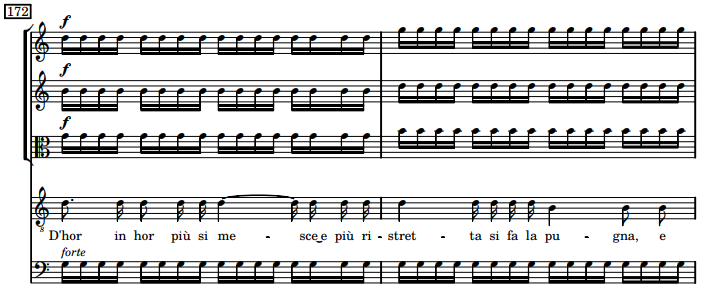Stile concitato
This article needs additional citations for verification. (April 2014) |
Stile concitato (rather Genere concitato[1]) or "agitated style" is a Baroque style developed by Claudio Monteverdi with effects such as having rapid repeated notes and extended trills as symbols of bellicose agitation or anger. Kate Van Orden points out a precedent in Clément Janequin's "La Guerre" (1528). Agathe Sueur points out similarities and ambiguities between Monteverdi's genere concitato and stile concitato in rhetoric and poetry.[2] [3] Examples of stile concitato can be found in these works:
- Monteverdi: Il Combattimento di Tancredi e Clorinda (written 1624)
- Monteverdi: Il ritorno d'Ulisse in Patria (1639)
- Monteverdi: L'incoronazione di Poppea (1642)
- Giacomo Carissimi (1605–1674): Jephte
- Barbara Strozzi (1619–1677): Tradimento
History
[edit]The earliest description of stile concitato comes from the foreword to Madrigali guerrieri, et amorosi ("Madrigals of war and love"), Claudio Monteverdi's eighth and final book of madrigals, published in 1638. Monteverdi wrote the following:
I have reflected that the principal passions or affections of our mind are three, namely, anger, moderation, and humility or supplication… The art of music also points clearly to these three in its terms "agitated," "soft," and "moderate" (concitato, molle, and temperato). In all the works of former composers I have indeed found examples of the "soft" and the "moderate," but never of the "agitated."[4]
Monteverdi developed the musical style of stile concitato to represent the human emotion of agitation. He considered Il combattimento di Tancredi e Clorinda, one of the pieces from Madrigali guerrieri, et amorosi, to be the first instance of stile concitato.[5] Stile concitato is represented musically in Il combattimento di Tancredi e Clorinda through the rapid repetition of sixteenth notes.

References
[edit]- ^ Gerald Drebes: ‘‘Monteverdis „Kontrastprinzip“, die Vorrede zu seinem 8. Madrigalbuch und das „Genere concitato“.‘‘ In: ‘‘Musiktheorie‘‘, Jg. 6, 1991, S. 29–42, online: "Gerald Drebes - 2 Aufsätze online: Monteverdi und H. Schütz". Archived from the original on 2016-03-03. Retrieved 2017-07-30.
- ^ Agathe Sueur, Le Frein et l'Aiguillon. Eloquence musicale et nombre oratoire (XVIe-XVIIIe siècle), Paris, Classiques Garnier, 2014, « Lectures jésuites du genere concitato de Monteverdi ».
- ^ Almeida, Vicente Casanova de. Monteverdi e o Stile Concitato – uma poética guerreira no Oitavo Livro de Madrigais de 1638. Dissertação. 2014. Disponível em: http://www.teses.usp.br/teses/disponiveis/27/27157/tde-10112014-144929/pt-br.php
- ^ Source readings in music history. Strunk, W. Oliver (William Oliver), 1901-1980., Treitler, Leo, 1931- (Rev. ed.). New York: Norton. 1998. ISBN 9780393966978. OCLC 38303611.
{{cite book}}: CS1 maint: others (link) - ^ Chafe, Eric Thomas (1992). Monteverdi's tonal language. New York: Schirmer Books. ISBN 9780028704951. OCLC 24142319.

